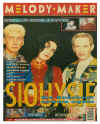
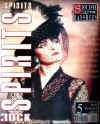
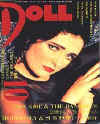
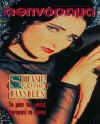
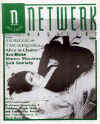
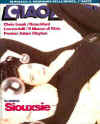
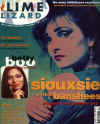
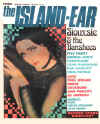
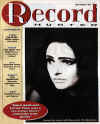
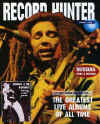
| SUPERSTITION - MAGAZINE COVERS | ||
|
|
||
|
|
||



 


 

|
||
| SUPERSTITION - INTERVIEWS/ARTICLES | ||
|
|
||
|
|
||
| MELODY MAKER 11/05/91 | ||
| BLITZ 1991 | ||
| RECORD HUNTER 01/92 | ||
| DEADLINE 08/91 | ||
| THE ISLAND EAR 20/01/92 | ||
| ROCK WORLD 01/10/92 | ||
| UNKNOWN SOURCE 1992 | ||
| MELODY MAKER 17/10/92 | ||
| SELECT 1992 | ||
| |
||
| MELODY MAKER | ||
|
|
||
|
|
||
|
THROUGH THE PAST, DARKLY 'Twice Upon A Time' is SIOUXSIE AND THE BANSHEES' second singles compilation, the sister volume to 1982's 'Once...' It's a testament to a band who came out of punk with more vision then their contemporaries, and retained their sense of dignity and wonder long after most of 1977's upstarts had burned out or faded away "WE’RE
SINGLE-minded," says Sioux. "It’s not worth doing
unless you’ve got certain values and certain standards, and you stick
with them. It doesn’t make you the most popular person always -
but that’s never bothered me." Cathi
Unsworth 17/10/92 |
||
| |
||
| RECORD HUNTER | ||
|
|
||
|
|
||
 PAINT IT BLACK
PAINT IT BLACK
Eyelined pharaohs of punk, the band who gave birth to Goth... Betty Page plots the turbulent first year of a seminal combo. Back in the mid ‘70s, in nice but boring suburban Bromley, Kent, when most teenagers were listening to The Eagles and Steely Dan and hadn’t relinquished their cheesecloth and flares, 17 year old Susan Dallion must have felt especially isolated. She was already a self confessed loner, and her taste in music reflected this. She favoured the renegades and outsiders: Bowie; Bolan; Roxy Music; The New York Dolls; The Stooges and Lou Reed. In 1974, at a Roxy Music gig in Wembley Stadium, a mutual friend introduced Susan to Steven Severin. They were soon to become kindred spirits, together in their splendid isolation. Steve then introduced Susan to his best mate (at the time): Bill Broad (later to become Billy Idol), a student at Sussex University. 1976 turned their world upside down. Early that year, Severin called his friend Bill to announce he’d seen a group called The Sex Pistols. Severin and Broad were so excited by their conversation that immediately the latter dropped his books and returned to London, and thus was born the infamous Bromley Contingent. This grouping was posthumously described in the Burchill/Parsons rock ’n’ roll epitaph The Boy Looked At Johnny as "a posse of unrepentant poseurs, committed to attaining fame despite their paucity of talent other than being noticed; achieving their aim by displaying themselves in a manner meticulously calculated to kill." The Contingent attached themselves to the Pistols and formed the nucleus of the embryonic punk scene. Susan soon reinvented herself as Siouxsie Sioux, dressing herself in what was then an outrageous amalgam of glam, fetish clothing and fishnet: peek-a-boo shiny plastic bras, spiky stilettos and swastika armbands; her face was painted "with the instinctive skill of the truly obsessed", as it was described at the time. She was the high-profile leaderene of punk style; "the female Sex Pistol"; the role model for a thousand bored middle-class girls who wanted to rebel. The media soon latched on to Sioux’s powerful image, and her scantily clad form was flashed across TV screens as she danced by the side of the stage when the Pistols played Islington’s Screen On The Green. But the fantasy-fetish look was a parody: "To show that erogenous zones are over-rated," she explained of the outfit, "and that tits are no big deal." And all this, ten years before Madonna had even seen a conical brassiere. Nevertheless, Siouxsie became the tabloids "pin-up punkette". Ms Sioux had anything but titillation on her mind. In September of 1976, London’s 100 Club held a Punk Festival week, an event now catalogued by many an apocryphal myth. One thing was for sure, though: the festival provided a platform for Siouxsie And The Banshees’ first performance. The ’band’ consisted of Sioux on vocals, Sid Vicious on drums, Steve Havoc (Severin had renamed himself, too) on bass and Marco Pirroni on guitar. None of the protagonists had ever played their chosen instruments or been on a stage before the night in question. And that, of course, was the whole point. Sioux - dressed as a mannish boy, her hair cropped - droned her way through a medley featuring barely discernable versions of the Isley Brothers’ ’Twist And Shout’ and Dylan’s ’Knockin’ On Heavens Door’, but chiefly an anarchic, thrashed rendition of ’The Lord’s Prayer’. After 20 minutes they got bored, limped off and the ’band’ split up immediately: Vicious to his tragic destiny with the Pistols; Pirroni to The Models, and subsequently to Adam And The Ants. Witnesses say the performance was a cacophony, but it kick-started more than one illustrious career. More importantly, it made the Banshees into a reality, because one admirer in the audience that night was Nils Stevenson, who linked up with Sioux and Severin to work on putting a proper group together. On December 1 1976, Sioux and Severin formed part of the Pistols’ entourage when they appeared on the now infamous ITV show Today, hosted by Bill Grundy. It was the latter’s provocative chat with Sioux which caused the verbal onslaught that followed. Everyone concerned became stars overnight. It was against such a controversial backdrop that ’original punk’ Kenny Morris joined the Banshees to play drums, with guitarist P T Fenton (otherwise known as P P Barnum) following in February 1977. The band would have joined the original Anarchy In The UK tour, but failed to get it together in time. Their first real gig was when they supported The Slits at the Roxy; they were unfocused but intense, toying with taboos: Nazi imagery, Manson chants, jabbing at the dark side, digging up hidden nasties, twisting the knife in the psyche. It was subject matter that inevitably attracted negative press attention, and guaranteed them a rough ride with the conservative record industry, who not surprisingly found this fascist fascination naïve and repellent. In July, guitarist Fenton departed, to be replaced by John McKay, who really helped the band find its feet. Having settled on the four piece line-up, they started gigging in earnest, supporting Johnny Thunders’ Heartbreakers and Manchester punk princes the Buzzcocks. But while most punk and new wave groups were putting out records as often as they had breakfast, the Banshees hadn’t been within sniffing distance of black vinyl. They made their TV debut on So It Goes that November and recorded a session for John Peel, but no deal emerged. Then the graffiti started to appear on walls in London: "Sign Siouxsie And The banshees". It got them rock press coverage, but still no deal. Even though they were breaking house records at the Vortex and selling out the Nashville - then prestige London venues - record company interest was conspicuous by its absence. The flirtation with fascist imagery was undoubtedly one of the principal factors keeping the labels away. But there was another reason: both manager and band were holding out for the best deal possible. Nothing less than total artistic control would do. At long last, however, they found a company who agreed to their terms, and in June, 1978, the Banshees signed to Polydor Records, for a rumoured advance of £400,000. 26 August 1978: ’Hong Kong Garden’ (Polydor 205 9052) So was it worth the wait? After all the talk of icy visions, Teutonic precision and morbid fascinations, a hitherto unglimpsed accessibility was revealed of the Banshees’ music, chiefly due to McKay’s chiming ’oriental’ guitar riff that rung deliciously throughout. "A brash, delirious two-chord triumph" announced the NME. It was to be one of their most successful singles ever, spending ten weeks in the charts, and peaking at a very respectable Number Seven. "Its oriental ’authenticity’, its flickering eroticism, its simple beauty pushed it deep into the charts," said Sioux sycophant Paul Morley at the time. Alienation certainly wasn’t on this takeaway menu. The single’s success ended the band’s isolation and gave grist to their uncompromising mill. December 1978: The Scream (Polydor POLD 5009) Their primal punk aesthetic laid to rest, the Banshees set the tone for their future with this album. There was a more stylised approach redolent of the Velvets’ gothic rock, with Sioux’s vocals evoking Nico’s deep, atonal drone. Punk prophetess Julie Birchill hated it: she couldn’t forgive Sioux for her apparent anti-Semitism, calling the band "a self-important threshing machine... loud, heavy and levelling, the sound of suet pudding." Nick Kent was more charitable, comparing the songs to a hybrid of the Velvet Underground and Tago Mago-period Can. Certainly it was jagged and jarring, in stark contrast to the chiming, charming single. Lennon and McCartney’s ’Helter Skelter’ took on a menacing mantle, as did ’Metal Postcard’ (dedicated to anti-nazi artist John Heartfield - the guilt purged?); ’Mirage’ was a roller coaster ride to the meat fetish horrorcore of ’Carcass’ and the psychosis anthem ’Suburban relapse’. Produced by the band with Steve Lilywhite, The Scream achieved Number 12 placing in the charts and put the Banshees firmly on the map - but on a much wider road than the dead-end that punk had become. 31 March 1979: ’The Staircase’ (Mystery) (Polydor POSP 9) Filled to the brim with elliptical guitar figures from McKay, this single failed to repeat the success of ’Hong Kong Garden’. Sioux’s voice was becoming even more commanding and trenchant, but the spiralling claustrophobia of the song made it a difficult listen; too demanding, perhaps, despite the lure of Bolan’s ’20th century Boy’, covered on the B-side. ’The Staircase’ reached number 24, a relative failure. Perhaps the problem with the Banshees was that they could never really write pop songs. ’Hong Kong Garden’ began to look like a happy accident. 7 July 1979: ’Playground Twist’ (Polydor POSP 59) Drums, chimes, fuzz, wailing... The Banshees’ third single from their forthcoming second album had a relentless, nursery rhyme quality, and was certainly not one of their more distinctive tunes. It would’ve been more at home in a gothic opera. Uncompromising, and a taste for... September 1979: Join Hands (Polydor POLD 5024) A progression? Well, not exactly. The parameters differed a little from those on The Scream, save for maybe a little added tension and melodrama and a "leaning towards a saturated, exaggerated punk MOR," according to Paul Morley in the NME. But even he, as a big fan, detected a formula at work here. ’Placebo effect’, ’Icon’, ’Premature Burial’: all were dark, neurotic mini-dramas with over-exerted, mannered vocals which to some tastes verged on the unlistenable. Fear, horror, ghoulishness and menace all abounded, but the puzzling thing was the apparently retro inclusion of ’The Lord’s Prayer’’ which took up 15 minutes of Side Two. It was the song that started it all, and the band had been finishing their live show with it for over two years, but it seemed incongruous. It was an uncomfortable, uneven LP, curiously fragmented. And the world was soon to find out why. The recording of Join Hands had opened up a fault line in the group. The fissure divided Sioux and Severin on one side and McKay and Morris on the other. The latter pair, who didn’t even help to mix the LP, had spent most of their time bitching behind Sioux’s back. The planned UK tour failed to get off the ground when McKay and Morris walked out of the band hours before the opening concert in Aberdeen, on September 7. The Cure, who were supporting, were forced to play an extended set. An irate Siouxsie went onstage to tell an angry crowd the pair had quit without warning. Rumours abounded that Pistols Steve Jones and Paul Cook might step into the breach, but a week later Sioux announced the new, then temporary members: Cure guitarist Robert Smith and ex-Slits drummer Budgie. The split made Sioux and Severin wary of making anyone else permanent, and the two remain as the solid nucleus of the Banshees to this day. But however traumatic the split may have seemed at the time, it was to herald a new and fruitful period of development for the band. The Banshees’ first 12 months provided chiefly stylistic influences. Sioux boosted sales of black hair dye and eyeliner for years to come, spawned a thousand look-alike Ice Queens and inspired a generation of Goths. The first year of their recording career provided inspiration for bands like Bauhaus, Sisters Of Mercy, All About Eve, Fields Of The Nephilim, and even now groups like Curve, Slowdive and Chapterhouse (the shoe-gazers) are sure to keep well-worn copies of the Banshees’ early recordings in dusty boxes at the bottom of their cellars. Betty Page 01/92 |
||
| |
||
| SELECT | ||
|
|
||
|
|
||
|
arsenic and old lace
Siouxsie doesn't like the '90s and it's all your fault. This generation, you lot, are 'sadly lacking' as far as youth rebellion goes. The glories of punk are recycled into comedy TV. So how does the Ice Queen survive in a time of global warming? David Cavanagh goes Sioux-gazing... THE VERTIGO SCALEXTRIC LOOP-DI-LOOP SCENARIO THAT LAYMEN know as the Hammersmith flyover must look pretty unspectacular from Siouxsie Sioux' window. With a non-committal grunt she lets the blind snap up, fidgets with fingers that still haven't learned to cope with their owner-operator's decision to sack the fags, and transforms her patented femme frigidaire veneer into some vaguely endearing it-were-all-fields-round-here-when-I-were-a-lass nostalgic moue. It's a gesture she will come back to again during the morning. Out there beyond the blinds chugs the number 11 bus, ferrying a new generation of post-pink shoppers to Shepherds Bush Shopping Centre, past the Hammersmith Palais where sweaty bloodletting gigs have yielded to godforsaken disco inferno nights and Esther Rantzen's Search For A Star auditions. A few miles away is Notting Hill, where Siouxsie used to live until this spring, when hassles and boredom and Poll Tax demands forced her out. The Sioux domicile is now in the south of France, where she shares house room with four cats and one budgie - her husband Budgie, the Banshees' drummer since 1979. She does call him Budgie, in case you were wondering. "And a few other things besides." She peeks once more out of the third floor of the Polydor building. She's seen them all come and go. Another Polydor employee is leaving today: eleven years at Polydor - a life sentence, but still three fewer than the redoubtable Sioux. Back home is the first garden she has ever had, and a chance to speak the language she first heard when her Belgian father used to sear at her in French when she was a baby. Over here is a London that means nothing to her and a monarchy that she and a few mates had a rather famous pop at some centuries ago, and which is now, ironically, decaying with every day. "Yes, the guillotine's been sharpened," she says warmly, peeking out at the flyover and the buildings that weren't there last time. "It's ironic." But it sounds like it's a fairly meaningless victory for her. "I'm disappointed with London," she says. "I think it's lost something vital. It's become safe and very complacent again. people are so self conscious about looking for the next punk thing, all ready to pounce on it and clingfilm wrap it. Whatever happens, it's got to be contemptuous of what's happening now and what's gone before." Hmm. Music is dying (runs her argument) and this generation are not worth saving. It's all a bit Imelda-Marcos-in-exile somehow. "This generation are like the love children. They grew up with parents that understood them. They grew up liking the same music. That's maybe what the problem is. The youth rebellion of looking at society and poking holes in it is sadly lacking in this lot, I think." Have you got any children? "No." Do you want any? "I've always said never," she replies after some thought. "But the idea isn't possible now." She's garbed in a startling combination of black leather and brownish lace. The waistcoat, trousers and boots are shiny black leather, the style of a woman who is just about to give a motorbike a really hard time. She has a small, black heart painted on the left side of her face, just under the eye. The eyes are black. Her bag is black. It's a bit fucking black in here actually. And under the black waistcoat is a brownish lace body wrap thing that appears to be see-through. Actually transparent. To stare would be ungallant, but, you know, while she's looking the other way out at the flyover... So, Siouxsie. The past. Siouxsie Sioux is one of the few rock stars who will admit to you that the current line-up of her band is not her favourite. That personal honour goes to the Siouxsie/John McGeoch/Steve Severin/Budgie line-up (1980-'82), the full-tilt orchestral power of which kicks off the new Banshees double compilation album, 'Twice Upon A Time', with the swaggering 'Fireworks'. That was, true enough, the stellar Banshees line-up: 'Melt!', 'Slowdive', the 'A Kiss In The Dreamhouse' album in 1982 and, God, all those strings. Siouxsie giving it the seven veils on Top Of The Pops in a golden antediluvian dawn before MTV or CDs or the resuscitation of the dinosaurs. The Ice Queen. Cruella De Wossaname. Budgie, whacking hell out of the drums. A mystery and a playfulness to the Banshees that yanked them out of the post-pink pack. Listening back to side one of 'Twice Upon A Time' must have been something of a blast for Siouxsie. She sounds like this was her favourite time. There was, she firmly maintains, "a lack of cynicism" about music at the time. Her subsequent flits in and out of fashion - there was a serious wilderness period around 1985-'86 which still brings a grimace to the Sioux features - have left her cool, detached and totally out on a limb. Anyone who can write off an entire generation as "this lot" obviously doesn't have a hell of a lot in common with her constituency, and yet she was still the first person Tim Burton called when he needed a new song for Batman Returns. Is is better to be in fashion or out of it? "Probably out. If you want your ego stroked, sure it's better to be in fashion. But anything in fashion will be out of fashion just as quickly. I've learnt to not take either particularly seriously." Who came up with the phrase Ice Queen to describe you? Was it you? "Naoww." Did it immediately appeal to you? "It went well with my fairy tale image," she says, laughing slightly, "but it wasn't really an accurate description of me. It was the impression of someone who'd probably never met me. Every person I've ever met since then has expressed astonishment that I haven't frozen them out or glared at them or bitten their head off." Well, the potential amputee would be excused for treading warily. Certainly, the personnel at Polydor all snap into action as soon as she appears, in a way that you suspect they don't when Little Angels come calling. They seem a bit scared of her. But if you tell her that, she gets embarrassed. "Oh.. right... I'm not aware of that." She breaks eye contact. The flyover becomes riveting once again. "But I think everybody should be treated with some respect." Do you think people are afraid of you? "Hopefully." You like that idea? "Yes." She nods slowly. "In a faceless place like a record company it can be useful. I mean, I can imagine Phil Collins walking here and it not affecting anyone." Phil Collins? "Unless they were told he had lots of money." Why Phil Collins? What brought him on? "I don't like people who don't have a presence," she says, just a little coldly. Yes, but Phil Collins? "I hate Genesis," she says with sudden vehemence. "I despise them. I hate the affableness of them, just that ordinary blokes... the... I hate their music. I hate how they put themselves across. I think they should be (she looks around for a suitable punishment)... torched. And Abba. Again Siouxsie Sioux seems somehow rooted in the past. Wasn't this a battle that was fought in 1977? Didn't she and the punks boyos get all this out of their system 15-odd years ago? "Well, maybe it's something personal then." Have you ever met anyone in Genesis? "No. And I wouldn't want to." It's a major beef, clearly. Weird. Is her music still important to her? Does it keep her going? "Yes it does," she says slowly. "Music makes you dig deep down inside yourself. It's still very vital to m. I'm still not content. I'm still digging in. I still feel very ignorant. So yeah, I've no idea what I'd do if I didn't do music." She has never acted, although you'd think she would have by now. The offers used to roll in - notably the role Hazel O'Connor later accepted in the distressingly putrid "punk movie" Breaking Glass - but now she's settle for a stylish cameo a la Nick Cave in Wings Of Desire or her hero William Burroughs in Drugstore Cowboy. What did she make of Sid And Nancy? "I hated that film," she says, animated once more. "I hated that glorification of it. I just was not interested. Horrible. Ugly. Not being in control of yourself. I hate the romanticising of being a victim." So go on then. What was Sid Vicious really like? "Well, before he was in the Pistols or after?" she says, mollified. "I knew him before he was in them. He had a great sense of humour, and his meanness always had a sort of black humour to it, which is something he lost when he became caught up in the Pistols' whole rock 'n' roll thing. I probably wouldn't have been able to have got on with him then. From what I hear he did change a lot. I saw him once and I almost didn't recognise him. He was just gone. He'd left the planet." Sid's former employer goes a bit quiet. This is about the longest speech she's given today. Siouxsie & The Banshees, of course, have never split up, so they have judiciously avoided all those tawdry getting-back-together atrocities to which their peers have repeatedly fallen victim. There are strong rumours as we speak of that... "Oh, the Pistols," she says, affecting an air of immense boredom. "Yeah. God, it's so ugly. If you stop you stop. I think the idea of reforming something that's gone, I just find it really ugly. it's like bald men combing their hair over. Just admit it. It's gone." Which punk bands did you like? "Quite a lot of people from America, like The Cramps. Suicide, Iggy even then. Early Wire. There's probably a lot more. If you prompted me..." Er, the Pistols? The Clash? The Damned? "Oh, the cartoons. Well, the Pistols were really important to me, but that was before they signed and released a record. It was the event of going to the shows that affected me. I've never played the Pistols since. I've never had a desire to." And there she was - large as life and twice as scary - standing behind the Sex Pistols and coming into our homes, when BBC2's Bank Holiday TV Hell extravaganza re-ran the infamous Billy Grundy/Pistols showdown from December '76. It was the bleached, teenage Siouxsie, and she was only on for the most fleeting of seconds, but it was definitely her: snotty, fearsome, uncommunicative. And around her slouched various surly, monosyllabic Pistols, most notoriously an irregularly-dentured yob with a severe social grievance who went by the name of Johnny Rotten. The day after this Siouxsie interview, he was up on stage at the Reading Festival regaling an audience whose language he didn't speak with taunts they were too bored to decipher. Blah blah... England is dead... blah... you're a blank generation... blah. Yeah, OK, John. If you say o. So that's how they scattered, then. One went to Los Angeles, the other went to the south of France. Neither of them has a hell of a lot to say about the country they left. For the last time today Siouxsie Sioux contemplates life beneath the flyover and audibly curses the day she decided to give up smoking. David Cavanagh 1992 |
||
| |
||
| DEADLINE | ||
|
|
||
|
|
||
|
It's not easy to picture Steve Severin,
bass player with Siouxsie & The Banshees, in a pair of gold lurex
socks. But there was a time when he couldn't go on stage without
them. Ludicrous, you may think, considering the cool, suave figure
who takes softly, punctuating his conversation with pregnant
pauses. Vaguely fetishistic. Or perhaps simply
superstitious.
'Superstition' is the title of the Banshees' latest album. Bathed in rich and golden imagery, shimmering with undulating rhythms and intricate ambitious strokes of musical mastery. 'Superstition' promises all the usual beauty and whispered spells which have always rolled and tumbled so exquisitely from this peculiar band. There's all you'd expect and nothing you'd expect. Siouxsie graces the sleeve, glowing like a legend from Hollywood, statuesque and ethereal, a goddess in a different disguise. A dance song (the one which broke the silence since 'The Last Beat Of My Heart', 'Kiss Them For Me') opens the bag of surprises and yet another transformation is complete. It's funny to think that people still associate this sumptuous sophistication with black bandages and complexions generally associated with the mortuary. Images are not easy to lose when they're powerful. Steve Severin is patiently philosophical about the need people have to persistently label his band 'goth', maintaining that moving away from that has not been a preoccupation, rather an evolvement. Although he does admit that the album cover was designed to establish a new and equally powerful image. "For a certain time the image was very strong and definable and so as much as we have tried to move away from it, perhaps we've been too subtle. For this one we had to do something like put Sioux on the cover looking completely different before people stood up and said 'it's a new image!" That dance song has helped as well. Critics either melted in orgasmic awe at the manifestation of something so completely unexpected and right, or said 'oh well of course dance has always been something to associate with the Banshees'. It gave them all a little piece of gold to chew over. "It wasn't particularly conscious. It wasn't chosen to be a single because of that. It was chosen to be a single because of Sioux's melody rather than the rhythm of the track. Other songs like 'Cry' we chose not to put out, because they were too close to what people might expect, but whatever you call dance music, it's really just the area where people are experimenting with sound, and it's of interest to us on a sonic level." Nonchalant detachment, a simple denial of cashing in on the dance craze, or merely how it was? Dealing in images, whether of themselves or those within their songs could lead people to wonder how contrived the Banshees may be. Beautifully, yet deliberately well thought out images maybe representations of something deeper, yet they do not necessarily have to be directly from the heart. Could there be a little of the voyeur in all of this? A smattering of detachment from the comfortable viewing position of a cosy backseat? Until Severin mentions dream diaries, Angela Carter and Indian academics you could conceivably be forgiven for thinking so. Yet not only is he obviously fascinated with the idea of myth, effectively trading in it through his work, he also believes in re-creating it for himself, thus realising the same applies to the band and the way people need to perceive them. The way people need images. "A lot of the stuff I was interested in last year was coming from Angela Carter (author of such modern day fairy tales as 'The Magic Toyshop' and editor of 'The Virago Book Of Fairy Tales') and Marina Warner (who's written extensively on myth and icons, notably Joan Of Arc and the Virgin Mary) and the idea of re-interpreting fairy tales. Angela Carter did that and Marina Warner concentrates more on why fairy tales became what they became, how society shapes them. It's quite interesting because most of them are really quite horrific and brutal to start off with, and end up as moral tales teaching people about right and wrong. It's to do with the idea of interpreting something in a completely different way. You wonder why people spin myths around this band. It's an interesting thing to play around with." 'Superstition' is scattered with images. The tragic Jayne Mansfield whose life ended on a curse, Elvis who sprang up in a dream Severin had, the dying earth and the unforgettable scenes of Tiannamen Square when a solitary figure beckoned death through the ultimate challenge. Myths and images of the 20th Century to play around with. "Dreams have always been important in the work of the band. Around the time of 'Kaleidoscope', Sioux had a period when she kept as notebook by her bed and started writing things down. I began doing it with this album, and the song that's most connected with that is 'Softly'. I had a dream that I met Elvis and all he said to me was "Softly". I also had this tape which I got in America. It was shrinkwrapped to a paperback called 'Is Elvis Alive?' and was supposed to be him ringing from a payphone explaining how he'd survived and what he'd been doing. There was nobody on the other end of the line. At the beginning and end of 'Softly' you can just about make out a short wave radio with bits of this tape in it. It's not important for people to know that, but it gives that atmosphere of something a bit more clairvoyant going on. The lyrics are nothing to do with Elvis though!" With 'The Ghost In You', Stephen Hague (who produced 'Superstition') tried to make me drop the reference to Tiannamen Square! But I think it's important to deal with those things, although in a different way, otherwise you're just sloganeering and it can come across as exploitative. That was stunning news footage, one individual stepping in front of a tank. Nothing has struck me that powerfully since." Maybe when Severin gets to America again he'll find something gross enough to stir him up. The band are heading across the ocean this summer to perform with Jane's Addiction, Ice T, Nine Inch Nails, Living Colour and the Butthole Surfers on the Lollapalooza tour. It's to be a traveling festival with music, art, politics and access to all information from gun associations and the army to ecological concerns fringing the aural delights. A stab in the fat belly of the 90's, it's an ambitious and imaginative way to get people to dance like maniacs for a day and invite then to do some worthwhile thinking into the bargain. Perry Farrell, lead singer and eccentric genius with Jane's, is behind the circus and bring an avid Banshee fan, he required their involvement. "We were the first band they approached, and in fact the only English band playing. I like the idea because it's ambitious and it doesn't really matter how well it works as long as everybody's having a good time." Severin claims the Banshees would have been involved if the only other attraction than the bands had been a hotdog stand. But he obviously gets a kick out of the subversive elements - and possibly shaking any aspiring Bob Geldof's upside down by their ankles along the way. "Lollapalooza is in a way what everyone's saying about the alternative culture with it's own newspapers and following. It's kind of an anti Band Aid thing. Of course it's great that people raise money for worthy causes, but at what cost? All the people that do it are well established bands and that's it. Rock music is not just for that, so if Lollapalooza is successful, it may be able to change things, not radically, but at least it can happen and that's a beginning." Lollapalooza will be swinging it's dusty way across America as you read this, but as I'm writing it the Banshees are still in rehearsal at The Rainbow in London. The place has been closed for years and now belongs to some dubious religious sect with evangelist leanings who insist on wandering around the stage during these rehearsals, no doubt looking for satanic symbols hidden in the roadies' bootprints and voodoo dolls behind the drum riser. Thank God they didn't find the backdrop. Severin explains, "It's from this area in the middle of India where there are 20 remaining temples out of 85, left over from the 10th century, and they're covered in erotic carvings. I found a book on it a couple of years ago and I began writing a song about it. Then strangely enough, we turned up at Top Of The Pops and they'd really made an effort with the set. Part of it was these relief figures, like jelly moulds, of two of these erotic carvings. We thought it was great, but they decided it was a bit too saucy for 7.30 viewing in the end. "I did some reading up about it, and I found this essay by an Indian academic about how people find these things pornographic. He was trying to explain why they were there and the connection with religion. It's something we got into before with 'Cities In Dust' - the idea of fertility rites. This one was actually about Tantra, the ritual sex that's supposed to bring you closer to enlightenment, but it quickly became used by the priests to bring in loads of temple girls. They turned it into an excuse, like most societies do. I guess now we're in an age where that sort of thing is promoted by advertising, the idea of consumerism being sold by sex, and it's not really aligned to religion anymore. Christianity put an end to that. "Spiritual sex, ecological awareness, tribal laments and Hollywood tragedies - it's all here. More than ever. Nearly billed as 'Thirteenth Hour' (being their 13th album if you count 'Nocturne' as a double), the name was changed for no particular reason, any concurrent thread running through the album being notably absent. "There's a good reason for superstitions though, a lot of them are based on rational fears. personally I'm very superstitious, particularly in work. Everything has to be done in a certain way. It's more of a psychological thing, you want a series of events to happen and if they don't happen in a certain way you feel... well, I believe in good and bad omens and coincidences. But it doesn't preoccupy me." Don't believe a word of it. He spent three years fretting about those gold lurex socks. Liz Evans 08/91 |
||
| |
||
| THE ISLAND EAR | ||
|
|
||
|
|
||
 Speaking
with Siouxsie and Budgie of Siouxsie and the Banshees, as The Island
Ear did at the conclusion of their recent club and college tour of
the States, it's hard not to be struck by how fat the band has come
without compromising its roots. Speaking
with Siouxsie and Budgie of Siouxsie and the Banshees, as The Island
Ear did at the conclusion of their recent club and college tour of
the States, it's hard not to be struck by how fat the band has come
without compromising its roots.
This is, after all, a band who came in to being by playing an extended free form version of "The Lord's Prayer", complete with Sid Vicious on drums and future Adam Ant Marco Pirroni on guitar, at London's 100 club in 1976. Fifteen years later, after a succession of albums that saw Siouxsie (whose given name is Susan Dallion) and bandmates Steven Severin, Budgie, Martin McCarrick, and Jon Klein, restlessly turn over their sound without regard to current style or fashion, the Banshees are no less quirky or difficult to pigeon-hole. They were, early on, a relentlessly grim band, most easily characterised by their abrasive style, and yet their biggest hit prior to this year was a techno-dance track called "Peek A Boo," from their 1988 release Peepshow. More recently, their single "Kiss Them For Me," was the second most popular modern rock track of 1991 (according to Billboard magazine), while the Gavin Report gives their album Superstition, an eccentric blend of alternative instrumental turns, Eastern mysticism, otherworldly eroticism, and tension, similarly high marks in terms of college radio play. behind the scenes the album marked the departure of long-time producer Michael Hedges, who had worked with the band since the early 80's, and the signing on of Stephen Hague, whose previous credits include the Pet Shop Boy's "West End Girls", New Order's "True Faith", and Pere Ubu's "Waiting For Mary." Which, in a round-about-way brings one right back to the question of just what this band is about anyway, and by extension, just what was the essence of punk. "It wasn't like 'I've read all the books you've read,'" says Budgie. "Punk was a whole way of life: fending for yourself and doing what you wanted to do. It was a bunch of people at a certain time and place saying, 'We don't need established BBC radio to do things. We don't need established official cinema to show films.'" And it was something, the Banshees' percussionist goes on to say, that caught on despite "the tabloids" efforts to contain it and make it safe. "Once they do that, the industries take over and you get your token punk on a sit-com. Innovation doesn't come from the big corporations, it comes from people who are willing to do the leg work on their own." What did Stephen Hague bring to the last album that you thought was missing in the past? Siouxsie: I suppose he brought in a bit of discipline, maybe. He's very deliberate and very methodical, whereas we tend to throw things at the wall and if anything sticks, it'll stay. So we sort of approached this project quite differently, but we also got him to work a bit differently as well, recording stuff live and that sort of thing. We're looking forward to the next thing we do with him and expect to do a lot of things live then too. Were you the person that decided 'We need this discipline' or did someone else come along and say, 'If you did it this way it'd be right'? Siouxsie: I think it was something that we knew we had to find, and Stephen Hague had been pursuing us for a few years, and it was just the right time at the right place, so we considered using him, and obviously we had to meet him to make sure it wasn't just a jobs-worth person that we were going to work with. We had to make sure we had similar ideas and taste. We certainly didn't want to have somebody discipline us that we didn't either respect or get along with. So we met him about a year and a half ago, in Santa Monica, when he was working with Robbie Robertson, and we seemed to hit it off pretty well and Superstition was the result of that. At this point in your career, how would you describe the creative relationship with the band? Siouxsie: Pretty chaotic. There's no set way of working. It tends to be, I'll have a very strong idea - be it a lyric or the music or the mood - or someone will be playing something, just doodling, and I'll pick up on it and say, 'What's that?' And magnify it and make it into something. Or someone will bring in an idea and we'll work on it. Some things just happen spontaneously, for instance "Softly" was written in the rehearsal studio with just Martin (McCarrick) and Steve (Severin) playing something and me sort of part ad-libbing off of an idea that I had, and then us working it out together after we'd taped it and decided it was something worth doing. Budgie: (On Superstition) some of the songs started with (Steven) Severin coming to grips with a computer, which was kind of a new way of working for him, and coming in with sequences of music. Which in turn was a great way to begin working with a new producer, because they could communicate quickly by transferring discs of information from computer to computer. That was one kind of direction that was happening. Meanwhile there'd be a lyric that was in constant development, and maybe a melody as well. Then of course we went into residential rehearsals where you just kind of kick around a lot of musical ideas and stuff. I was playing around with a lot of different rhythms and beats - as usual - and even as we got to the recording studio, where we were actually laying down tracks and things, we still kept little areas of the studio building available for people to escape to in order to create. 'Under the stairs' we called it. There was a little closet under the stairs and it was, 'Who's in the closet today'. And some of the things written in there, like "Spiral Twist," ended up as B-sides. We actually had more than enough songs this time around, causing us to toy with the idea of a double album at one point (laughs). What do you say to people who might consider composing on computers as the antithetical to the idea of rock and roll as organic music? Budgie: But look at rock and roll, or whatever you want to call it; the whole things came about only because equipment got amplified. When Hendrix picked up an electric guitar and started making noise with it, the whole excitement came from the switch from what Elvis was doing or something. It suddenly became different because people were using the equipment that was new at the time, and I think it would be wrong to say, 'Oh well, this is as far as it goes. We can't use this because it's new, it's modern, and we don't understand it.' People are always frightened by new innovations, afraid, in a sense, that those innovations are going to take over and they'll lose that kind of organic integrity of the truth or something. It just means that you've got to be careful that it doesn't get out of hand and you're not used by it. You have to use computers the same way you use a recording studio, which itself is just a massive piece of technology. Was creating "Kiss Them For Me" any different from creating things that were... less successful in the past? Was there something you consciously did differently? Siouxsie: No. (laughs) In a word. And that's pretty much the way most singles start out, in that they're not normally written as singles - it all depends on how they turn out. "Peek A Boo" was a song that was going to be a B-side and as that progressed we thought, 'Oh, that should be a single.' It wasn't written as a single, but it turned into one. Budgie: It's funny because it seemed to me that "Peek A Boo" was to Peepshow what "Kiss Them For Me" was to Superstition. It's the one song that was pushed right to the limit, in a sense. We laid way any barriers at all and we were constructing something entirely new, not really knowing what it was going to sound like. The song is peaking at the point that you hear it, in a construction sense anyway. It went way out there. (laughs) And what can I say, if people picked up on it, that's great. What propels the way the band keeps reinventing itself from album to album? Siouxsie: I suppose just our giving ourselves enough space in-between albums. We're very aware of not wanting to repeat ourselves and going too quickly from one album into another, as if it's a continuation. We realised very early on that every new album needed its own identity. You need to sort of gear yourself up in that frame of mind for it. Budgie: It gets back to the fact that you want to do 'another' album. We don't want to just tread water and do something we've already done. people always want to define what it is that groups do, but our sound is the fact that we keep reinventing it. However, I'm sure that somehow it becomes apparent that the members of the group are integral to the sound of the band and that's what makes the Banshees the Banshees. If you're just fulfilling another commitment, doing something that you're not really motivated to do, that's when you end up with something routine. We've always avoided that. Why is it that this band was able to survive when a lot of your contemporaries, people like the Clash and the Sex Pistols, didn't? Siouxsie: I think because of the openness of it. We've always said that as soon as we feel trapped or for some reason unable to do things the way we want to do them, then we wouldn't do it anymore. And we've held on to it belonging to us all the way through and not really relinquishing anything to anyone. Early on I imagine you thought of your music as a way to combat some of the staleness that had entered what we now refer to as classic rock. Do you still see your music as a vehicle through which you're rebelling against... whatever you want to rebel against? Siouxsie: I think obviously the impetus of how we were born was very much a direct result of what was going on around us. And the thing you just mentioned was a part of it. But also the way London was as well. There were a lot of closed doors. And as you progress you end up having your own demons to exorcise. In other words, the further you go along, the more it becomes a process of looking inward at yourself. Siouxsie: I suppose so. Obviously you're still effected by outside elements, but I think... yeah, I suppose it's more inward. Now you mentioned closed door before. What did you mean by that? Siouxsie: Well you were saying musically that things were very stale, but also it had become a very insular thing, which it should never be. It should always be very open to anyone who has got something to do or say. That was what was very exciting in that all of a sudden you didn't have to be able to afford to but equipment or take lessons in how to play an instrument or go to music college or whatever. It was something that could work on the spur of the moment and on the energy of what you were feeling as opposed to any privilege you might have, being introduced with the music business. You recently played C.W. Post, and it seemed like the majority of people in the audience were young enough to have been only five or six when the Banshees came together... Siouxsie: Or not born. (laughs) Do you think they get where the band is coming from? Is it important that they get what the band was about back then? Siouxsie: No. I think it's important that it means something to them now. Right here and now. When you look out at the kids in the audience today, do you see a youth movement? Budgie: The only thing that I can see at the moment that certainly grew out of what the kids wanted, and that nobody saw coming, is Nirvana, whose success, I think, reflects the fact that they've just had enough of House Music and Acid House and the Manchester scene. That's the way it seems to me, but whatever it really is, I probably don't know about it. (laughs) Are record buyers as or more open-minded as they were 10 years ago, 15 years ago? Siouxsie: I think there will always be a portion of the record buying public that will be (open-minded). I don't think they're the majority, but I do feel that there will always be a section of the audience that is open and seeking something that is expressing what they feel as well. Do you think that the success of Superstition can be attributed to the fact that as the band matures it's actually becoming a more professional unit? Budgie: No I don't. I would hope it's because people are getting genuinely excited by something we've done. We are as 'professional' as we would like to be, in the sense that there are things that we consider doing, like coming into Geffen and doing interviews. There are certain things you do. But when you're in the studio, that's private. That's not a profession that's your lifeblood. That's what you do. That's what comes out. So the last thing in your mind is what comes into gear after the studio part is finished i.e. meeting with people and even touring to a certain extent. When you started with this rock and roll thing, did you ever think that this is where you'd end up? Siouxsie: Oh no. There wasn't really any concept of what the future would hold - and there still isn't. It was really just a case of our doing what was right (at the time). I mean, the band started with the idea that we'd do ten minutes and that was going to be the only show, and it's gone on from that - for reasons partly out of our control and partly in our control. I like to keep it open in that way. Danny McCue 20/01/92 |
||